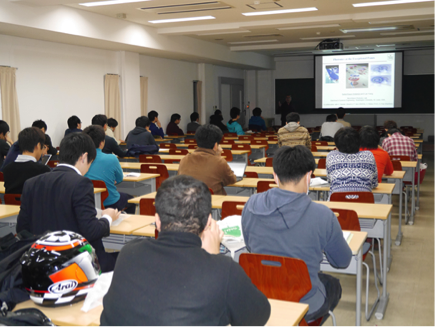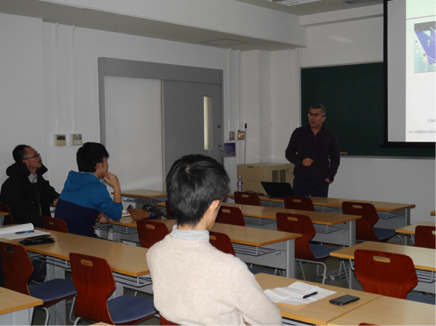活動報告Reports
第9回 固体物理セミナーを開催しました。
2014年12月8日
2014年12月8日(月) 13:00~14:30
大阪大学基礎工学部 B103講義室
講師名:Sahin Kaya Ozdemir 特任教授
講師所属:大阪大学大学院基礎工学研究科/ワシントン大学
講演タイトル:「Physics and Applications of Whispering-Gallery-Mode Optical Microcavities」
要旨:Whispering-Gallery-Mode (WGM) optical microcavities with their high-quality
factors and microscale mode volumes enables strong light-matter interactions and thus have emerged as versatile platforms for exploring basic science and for fabricating functional devices.
In this talk,I will briefly review WGM resonators and introduce their Physics and applications. In particular I will focus on (1) detection of very small nanoparticles (below 10 nanometers in size) using WGM microresonators and microlasers, and (2) on-chip control of optical processes and light transmission in systems of coupled WGM resonators
(WGMRs). WGMRs represent open physical systems that are characterized by non-Hermitian Hamiltonians, and thus by appropriately steering the system parameters, their complex eigenvalues and the corresponding eigenstates can be made to coalesce giving rise to a degeneracy referred to as Exceptional point (EP). I will present two applications enabled by driving coupled WGM microcavities through exceptional points. First I will show parity-time (PT) symmetry and its breaking in a system composed of two coupled WGM
microcavities, one of which has passive loss (passive resonator) and the other has optical gain (active resonator) balancing the loss of the other.
By controlling the inter-cavity coupling strength, one can drive the system from PT-symmetric phase to the broken PT-symmetry phase through an EP. The broken phase enables localization of light in the active resonator, leading to nonlinearity-based nonreciprocal light transmission (optical diode). Then I will show that modulating the loss contrast between two coupled passive resonators can bring the system to an EP where the total intracavity field intensity increases despite increasing loss. This then helps to control intensity-dependent optical processes by loss modulation without requiring optical gain. I will end the talk discussing some of the opportunities and challenges in the WGM research.
<主催した先生から>
「微小円形素子における囁く回廊(WGM)現象」が世界的に研究されている。囁く回廊とは、世界各地の円形寺院で見られる「囁く回廊」の音響現象を極微小の光共振器の世界に持ち込んだことに由来する。その研究の第一人者であるワシントン大学のオズデミル先生の理論および実験研究を、本講演で話していただいた。精緻な理論と実験の結果は大変迫力があった。特に、2つのドーナツ状共振器を接近させ、片方に光増幅機能を持たせもう一方に光損失を持たせた場合に、どちらに光を注入しても増幅機能を持たせた素子から出て行くという非対称な現象の実験は面白い。これは今後のシリコンフォトニクス情報処理に大きな威力を発揮しそうである。従来このような「対称性の破れ」の現象を起こすには磁場または進行波型変調のように時間反転対称性のないメカニズムが必要であったが、非線形相互作用を用いた実験は新しい局面をもたらすものである。オズデミル氏はプラズモニクスや量子情報理論にも長けているが、今回は今年の成果に関係した内容を基礎から講演いただいた。
オズデミル氏は日本の大学のみならず、人種のるつぼであるアメリカの大学で教鞭をとられていることから、聞き取りやすく論理的でわかりやすい講演を行う。今回はご自身の研究紹介であったが、量子力学から電子回路まで幅拾い科目の授業をこなす。また今回は日本語を披露しなかったが、実は日本語の日常会話も達者である。今後このような人が日本の大学での教育・研究に引っぱりだこになるであろうことを予感させる講演であった。
(井元 信之教授)





